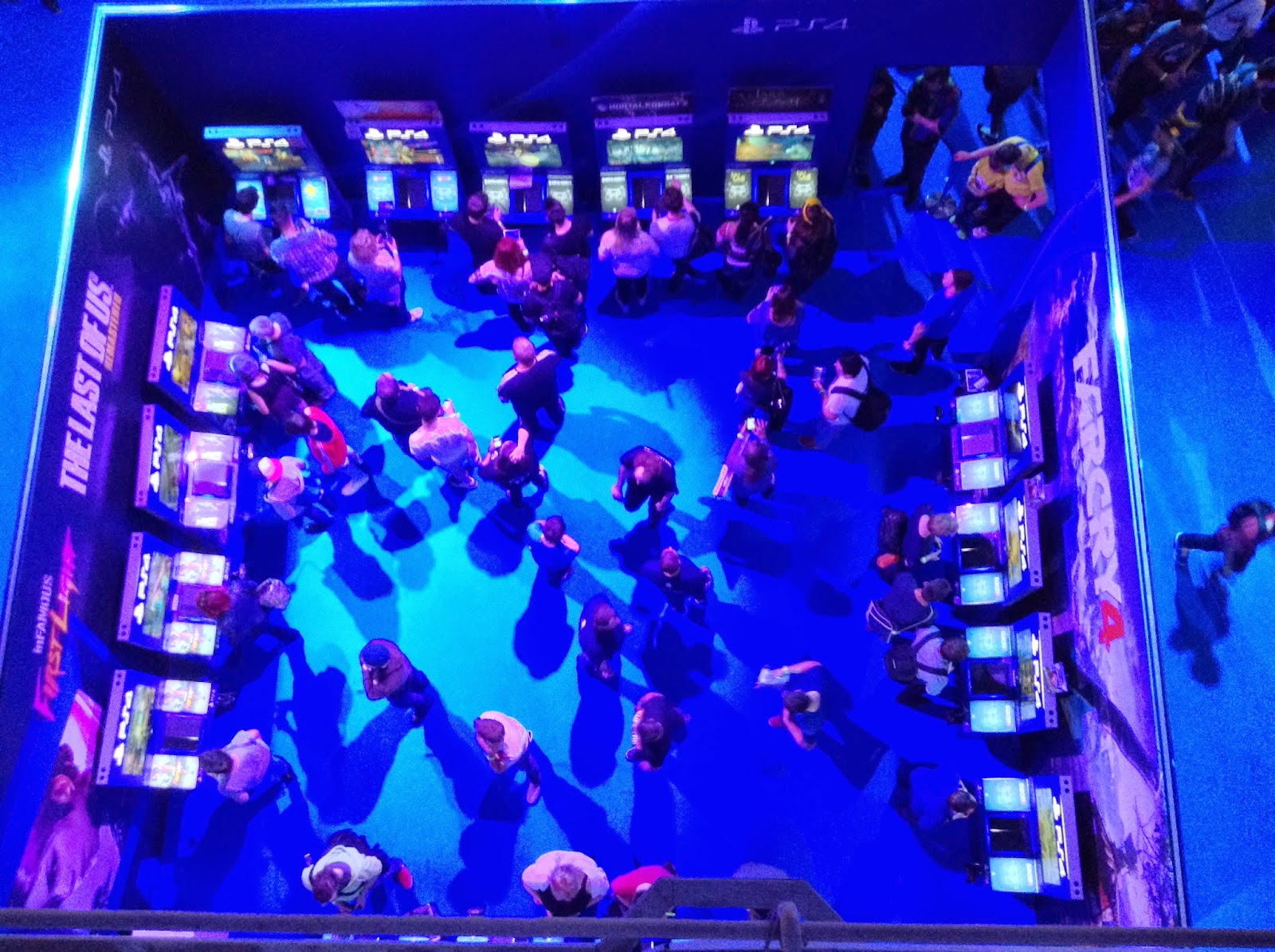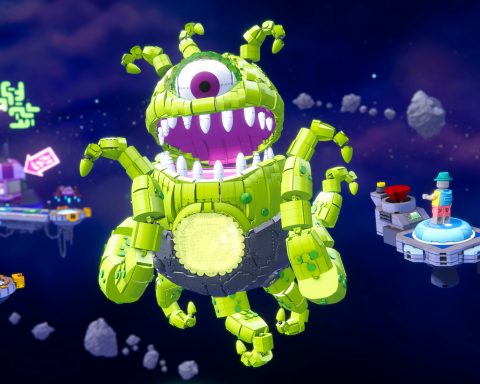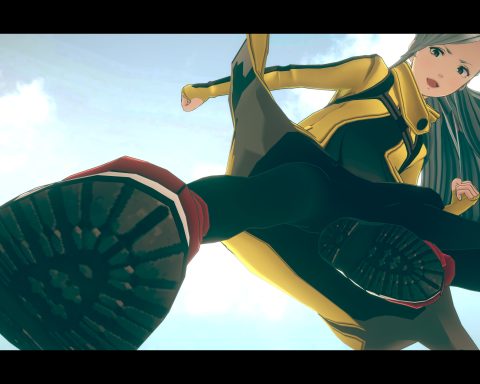 Report by David W.
Report by David W.
EGX has been around in some form since 2008 as Eurogamer’s UK gaming showcase. With a steadily increasing attendance which reached 70,000 last year, its four day tenancy at Earls Court Exhibition makes it one of the biggest of its kind in the UK. Though it does have development showcases it may not be seen yet as London’s answer to E3. Rather, much like Sony’s tag line for the PS4, EGX “is for the players.”
EGX is first and foremost a consumer showcase and primarily features a hands on approach to AAA-games soon to be released on the major console platforms and PC. The two floors of the Earls Court venue are packed with studio stands and associated ‘gaming booths’ that provide many players with their first taste of new titles. The show also contains competitive gaming arenas with eSport commentary on games such as League of Legends, and classic gaming championships running throughout the day. A program of developer talks runs concurrently, and the much loved retro lounge, now ubiquitous at such events, offers nostalgic trips back to old favourites on past console generations.
Nintendo, Microsoft and Sony all had a prominent presence, with dedicated areas for all the big hitters you would expect such as Call of Duty and Halo: The Master Chief Collection multiplayer. Nintendo’s major attractions were Splatoon (a multiplayer explosive paintballer) and Super Smash Bros for Wii U and 3DS. The virtual reality developer Oculus VR showcased their Oculus Rift 3D VR headset and drew crowds with its playable VR demonstration of The Creative Assemby’s Alien: Isolation.
As a result of this abundance of content and subsequent gamer interest, one of the triumphs of EGX is its excellent management of space and crowds. The ability to turn over huge crowds (and keep them moving), ensures all attendees get individual play time with at least some of the major titles in development right now. I never waited more than 20 minutes to play and, by arriving early, in some cases I was able to find a free gaming booth immediately.
Assassin’s Creed: Unity
Ubisoft had some strong contenders on show with Far Cry 4, and Assassin’s Creed: Rogue, as well as The Crew for the first time on console. Ubisoft Montreal also presented live gameplay showings of Assassin’s Creed: Unity, introduced with a pre-rendered CGI trailer of the game. I’m always suspicious about movie trailer graphics that never feature in actual gameplay, and so was grateful at the chance to see actual gameplay handled by a Ubisoft staff member.
In this demonstration we see Arno (the new AC hero) infiltrate the Notre Dame de Paris cathedral and assassinate an NPC. It’s a sequence picked to show off the games’ multi-approach mechanic to mission solutions. According to creative director Alex Amancio on Eurogamer.net, “no linear paths or narrow level design are forced upon you.”
However, the developers have played the same mission before in exactly the same way in front of crowds at E3 and Gamescon. Each time we watch Arno stalk through THIS crowd, hide behind THAT wall, loop around THOSE guards, enter through THIS window and with no deviation from said path. As Unity was unavailable for hands on public play, I wondered if, without the guiding hands of a Ubisoft staff member on the controllers, slight deviations from this rehearsed route might result in a mission insta-fail, something which proved so frustrating in previous AC games.
Ubisoft in typical pre-release hyperbole promise that AC: Unity is truly a next gen gaming experience, but aside from it only being released on next gen consoles, it isn’t clear quite yet how that statement is to be fulfilled. Yes the graphic fidelity is there; yes there are far higher NPC counts and a more natural crowd AI; and yes we have highly detailed building construction and ridiculously lifelike surface textures. But whilst it looks beautiful it still seems to look, sound and ‘smell’ like every Assassins Creed game gone before. Whilst for many this may be the carrot of return, for me it’s the stick. The new parkour system of movement, a fast and fluid point-to-point traversal across the level map is so subtly tweaked from AC: Black Flag, that it’s hard to tell what major innovation it brings apart from new ‘turn on the fly’ animations and a more graceful and speedy vertical descent from buildings. We are also promised a stealth mode but it was unclear as to what this meant or how it is implemented.
Assassin’s Creed: Unity will release on 11th November in North America and 13th November in PAL regions with a later release for Japan on 4th December.
Far Cry 4
With Far Cry 4, another Ubisoft open world, the game presents us with a wider range of options on how to approach missions, who to kill first and how to kill, paths to take, elephants to ride upon into battle (or not), takedowns to perform silently or with explosive flair and most crucially ‘game over’ screens that result from actual death and not just a break in stealth. Playing Far Cry 4 after watching the Unity demo was like being given back free use of my limbs after being tied to the underside of a cage for an hour. Limbs that could wield grenades and shotguns I might add. FC4 induced such feelings of player agency that it left me wondering why, despite Assassins Creed not being a first person shooter, Unity couldn’t at least borrow from the genre a little.
The recalcitrant idea of killing people where, when and how you like, without some disabling system prompt reminding you to do exactly what the developers want might benefit the AC franchise. It could be more revolutionary for Unity than the storming of the Bastille. Far Cry 4 is on the other hand, not so much a clone of its predecessor Far Cry 3 but an heir apparent. Taking all the best bits and adding more, it has all the solid, satisfying combat, anxiety inducing self-healing mechanics, weighty gun play, and addictive enemy outpost assaults of its previous incarnation plus elephants! In the level we had access to I was tasked with riding an elephant in to clear a fortified enemy camp. In a return to the excellent wildlife sound design of Far Cry 3 my steed trumpeted, and thumped into battle, smashing open the fort door and hurling enemies gasping against the ground with its trunk. The melee animation is also fresh, frenetic and fun… if you can call stabbing men in the back by surprise ‘fun’. But when it’s realised this good in a game, I call it fun.
Far Cry 4 is out on the 18th of November, on Xbox One and Xbox 360, PS3 and PS4, and Windows PCs.
Alien: Isolation
With Alien: Isolation, SEGA have burst out of the chest of the Alien franchise mould, (a guns-a blazing-Xeno-reaping gaming formula that recently ended with the dismal reception of Aliens Colonial Marines in 2013). Alien: Isolation developers The Creative Assembly have expertly crafted a survival horror on board a remote space station (eerily detailed with the original film’s 1970s vision of futuristic tech). You play Amanda Ripley, Ellen Ripley’s daughter. Armed only with a motion tracker, some flares, and possibly a flamethrower (if you can find it) you are being hunted. The signature blip of the infamous tracker marries the thump of your rising heart beat to the approach of a stalking Xenomorph with life-like precision and you must run, and run fast, to the nearest exit.
The brief time I spent with the game was certainly nerve-rackingly immersive. A workstation table cluttered with abandoned equipment became my best friend as I hid in its dark shadow for two gut wrenching minutes. A familiar serpent tail coiled and uncoiled in the darkness only meters away.
“If it sees you,” we are told by a man who clusters us together in the dim green light of the lobby area “break its line of sight and run!” We all laugh. Nervously.
Ten minutes of running and sneaking in the dark smoky corridors with a Xeno so adapt at conduit traversal (and I suspect a bit of AI teleportation), that after my third death at the expense of its prehensile claws I was ready to take a breather. It looks great. It handles well. You could soak up the atmosphere with a dry cloth and create a knock-out brand of gaming chloroform with this bad boy. The games’ ability to make you feel, perhaps for the first time, that you’re on THAT ship with THAT creature is unparalleled. On the more nit-picky side, whilst up close the Alien is every bit as terrifying and Giger-esque as you’d expect it to be, I was somewhat disappointed by its human-like animation from a medium to long camera angle. Aliens should leap, crawl or bound, like feral animals and never walk like a man in a 9ft rubber suit. Ok, it’s not that bad, but it’s not quite good enough. I’m also curious as to see how the dynamic of running and hiding without any real muscle power can be kept going for a full game (it quickly became exhausting and stale in Outlast and that only lasted 5 hours). Can the ‘no guns hide and seek’ conceit can be stretched out for the double digits of gameplay a big budget release like this requires? You can see for yourself on its 7th October release.
Dead Island 2
Dead Island 2 was another game I was keen to experience and I was very grateful to have the chance of participating in a four-player coop timed trial. With a pew-pew pistol like gun, I felt at a distinct disadvantage to my electrified shotgun toting teammate. I would have been more interested in sampling a part of the actual campaign so I could take time to soak up the finer details of production, but instead, and in true multiplayer fashion I was running around lopping off heads in pursuit of a higher kill count. Rubbish gun notwithstanding I can’t deny the visceral effect of my machete’s power attack that spattered zombie blood in arching geysers across the screen.
Dead Island 2 is a glossier, meatier, and more graphic sequel to Dead Island and Dead Island: Riptide and contains all the well liked tropes of zombie destruction, and frenzied looting that’s found in those games but with a higher frame rate and resolution to boost. According todigitalspy.co.uk “The Dead Island sequel.. features the same ability to hand-craft weapons, but introduces redesigned combat, dynamic challenges and new enemy types. It also introduces eight-person seamless multiplayer, tasking players with co-operating, competing and coexisting in the same world.” It’s expected to be released Spring 2015.
The Witcher 3: Wild Hunt
The Witcher 3: Wild Hunt looks in great shape based on the presentation we saw by developers CD Projekt Red. Dynamic weather schemes, day and night cycles that affect the type of enemies spawned; and tense hack and slash combat with a visually nuanced and real-worldly use of magic. Each spell you wield animates the dynamic terrain. Grassland is charred, pushed aside and flattened. Ripples and waves show the flow of your released energies across pools of water in muddied woods; Geralt the main character and the arcane forces he wields, feels in real contact with the designed environment rather than just inhabiting it. Damien Monnier, Senior Game Designer, took us with heartfelt enthusiasm through a mission early in the story. We are tasked with finding an ashen-haired girl.
We must make a pact with three deformed sisters who exist both in beatific painted effigies and in the real world as grotesque Brother’s Grimm imaginings. The creature designs look like they’ve come right out of some nightmarish Nordic fairy tale. Animations breathe life into the games’ creature effects, constructing fascinating entities that have been pulled and twisted into a freakish visual treat. The pace of the quest isn’t always consistent and can be a little wordy but the voice acting is superb, and the cut scenes mesh well with the live action play with the choice of speech options genuinely influential in the way the story is told. Designer Monnier was keen to point out the focus on player choice throughout the game. The specifics of which dispense with stylised morality decisions and black and white answers that create polarised alternate endings. Instead, player choice influences a gradual unfurling of over 30 possible game states. The user interface looks gorgeous and easy to access on console and I wish I could have spent some time playing the game myself, ahead of its release in February next year.
Round Up
The show this year demonstrated that despite the initial drought, there has never been a better time to own a piece of next gen hardware. Over the next few months expect to see a glut of games on next gen consoles, finally providing gamers with a payoff from the investment in the hardware that was made available only a year before. EGX sought to entertain gamers of all ages and abilities, even including a section by Special Effect, an organisation running adapted hardware and software to make gaming more accessible for gamers with disabilities.
Despite all the blockbuster releases and eye-popping graphics, a highlight of the show for me was playing Dirt 3 with an adaptive infra-red optic camera. It tracked my eye movements and mapped them to in-game controls so that I could accelerate, break and steer using only my eyes. It was an incredible application of tech and felt like I was playing a game using only my mind, which for me, was a defining moment in my gaming consciousness. THIS surely was a true next gen experience, which Ubisoft might consider, before they begin writing their superlative press releases for the next assured entry in the Assassins Creed franchise.
– David W.
Contributor











